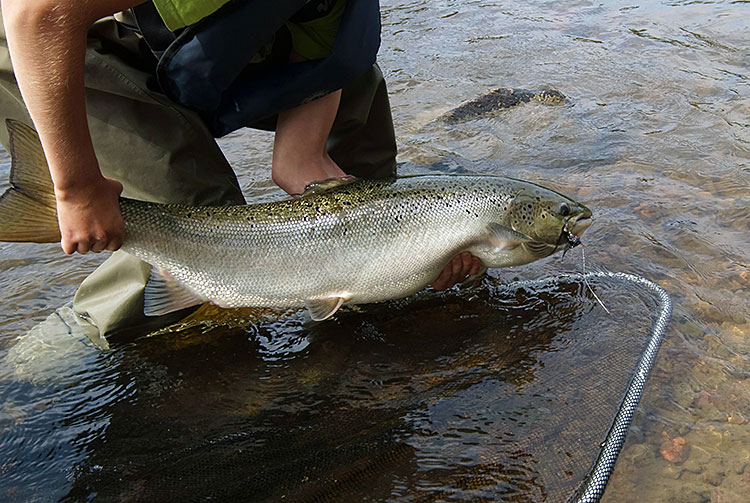On March 13, on recommendation from California and Oregon agency representatives and industry advisors, the National Marine Fisheries Service took inseason action to cancel ocean salmon fishery openers scheduled between Cape Falcon, Ore., and the U.S./Mexico border through May 15.
The sport fishery had been scheduled to open off California in most areas on April 1.
The Pacific Fishery Management Council produced three regulatory options for May 16, 2023, through May 15, 2024. None would authorize commercial or ocean salmon sport fishing off California until April 2024.
The PFMC approved these alternatives for public review.
On March 21, the PFMC will hold a public hearing in Santa Rosa to receive public comment on the three proposed regulatory options. The PFMC will then meet April 1-7 in Foster City to adopt final regulations.
More information can be found at www.pcouncil.org.
•••
Original Article
Scientists: Ocean Salmon Outlook is Poor
State Fish & Wildlife: 2023 Fishing Season May Be Restricted
At the March 1 virtual salmon information meeting, state and federal fishery scientists presented the numbers of spawning salmon returning to California’s rivers late in 2022 and projected one of the lowest forecasts since 2008.
The forecast for Sacramento River fall Chinook, the most predominant stock harvested in California’s fisheries, is estimated at 169,767 adults, one of the lowest forecasts since 2008 when the current assessment method began.
For Klamath River fall Chinook, the forecast is 103,793 adults, the second lowest forecast since the current assessment method began in 1997.
Neither forecast is the lowest on record.
In 2009, the Sacramento forecast was 122,200 and in 2017, the Klamath forecast was 54,200.
Salmon numbers are episodic over time and life cycles, a three-year period from birth as eggs hatching to returning adults from the ocean. For example, in 2022, ocean commercial catch was considerably greater than preseason expectations.
The data indicate abundance is higher after wetter years. For example, the 2010 rainfall was above average rainfall year and forecasts for California adult Chinook in 2012 and 2013 were higher.
Drier years regularly are followed by lower abundance three years later. Three years ago, in 2020, drought conditions were particularly severe.
“This is a decades-long trend, and the past few years of record drought only further stressed our salmon populations,” said Charlton H. Bonham, Director of the California Department of Fish and Wildlife. “Unfortunately, low stock abundance is somewhat expected despite protective and restorative actions California has taken to increase hatchery production, improve release strategies, and increase the availability of critical spawning and rearing habitats.”
The current wetter weather in California is good news. Relatively higher returns in 2019 and 2020 may help boost the number of spawning adults returning to the Sacramento Basin in 2023, as fish hatched in 2019 and 2020 will be returning this year.
Scientists expect this boost will be moderated by ocean conditions and climate disruption, but see bright spots and reasons for caution on the horizon.
Rebuilding plans have been developed for the Sacramento River fall Chinook and Klamath River fall Chinook stocks after multi-agency collaboration between the Pacific Fishery Management Council, CDFW, National Marine Fisheries Service, U.S. Fish and Wildlife Service, Tribes and industry representatives.
Other ambitious efforts to rebuild salmon are continuing, notably the largest river restoration and dam removal project in the nation’s history in the Klamath Basin.
The salmon meeting was attended by fishing industry participants, conservation organizations and other interested parties. During the meeting, ocean and in-river recreational anglers and commercial salmon trollers asked questions about the latest numbers and provided comments during a public listening session.
Stakeholder input will be taken into consideration when developing three ocean fishery season alternatives during the March 5-10 Pacific Fishery Management Council meeting. Final ocean salmon season regulations will be adopted at the April 1-7 meeting.
The California Fish and Game Commission will consider and approve inland fishery seasons and regulations this spring, with final decisions in May.
Following several years of poor returns to the Klamath River Basin, Klamath River fall Chinook salmon were declared overfished in 2018 and have not yet achieved a rebuilt status under the terms of the federal Salmon Fishery Management Plan. In 2022, returns of Sacramento River fall Chinook fell well short of conservation objectives, and now may be approaching an overfished condition after being declared rebuilt in 2021.
As a result, federal and state agencies are expected to take a conservative approach when approving 2023 salmon seasons to provide additional protective measures to these stocks, and very limited or no fishing in 2023 appears possible, according to CDFW.
•••
To access information presented at the March 1 meeting, visit CDFW’s Salmon Preseason Process web page. General ocean salmon fishing information can be found on CDFW’s Ocean Salmon Project web page or by calling the CDFW Ocean Salmon Hotline at (707) 576-3429.

